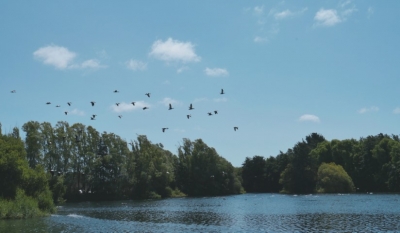Good neighbours
ISAAC CONSERVATION AND WILDLIFE PARK CENTRE
A short drive from Christchurch Airport is a 1100-hectare block of land where construction, quarrying, concrete and asphalt companies, livestock and salmon farming co-exist with conservation in a unique business model.
The land is owned by the Isaac Conservation and Wildlife Trust, which was formed in 1977 to continue the conservation work of Sir Neil andLady Isaac, Diana, who had ownedand lived on the land. “Their intention was to leave the place in a better condition than they found it,” says trust administration manager Catherine Ott.
In the early 1950s, Sir Neil and Lady Isaac founded Isaac Construction.
The tagline of combining construction with conservation demonstrates the construction company’s commitment to conservation.
Today the successful construction company is one of the leaseholders on the land which provide the income for the land rehabilitation and conservation activities. Catherine says this business model is really important because it means the trust is self-funding and can exist in perpetuity without the need to fundraise. The assured income also allows planning for the future with confidence.
The main focuses of the trust are the conservation of endangered native flora and fauna, conservation of heritage buildings and the study of conservation through education and research.
Peacock Springs, which covers 73 hectares, is the main conservation area where the endangered NZ species are bred for release into the wild. It is off-limits to the public.
The trust has a memorandum of understanding with the Departmentof Conservation who has requestedthat the trust currently focus on fivebird species – whio (blue duck), pateke (brown teal), black stilt (kaki), orangefronted kakariki and the New Zealand shore plover.
The orange-fronted kakariki numbers were desperately low, Catherine says, and though the DOC put them on predator free islands, they didn’t thrive as well as expected. DOC now release them in the south branch of the Hurunui in the Arthurs Pass region where intensive predator control is undertaken. At the time of writing there are thought to be 200 to 300 orangefronted kakariki alive there, however this population could crash at any time. “We have specialised knowledge
garnered over 20 years in the captive breeding for release. Another reason for our success is because we are not open to the public. The aviaries are not designed for display but for breeding, so you may never see a bird.’’
The kakariki thrive best in dense, dense bush. “Our aviaries are so densely planted, when chicks fledge, it can be very difficult to locate them.”
Catherine says Peacock Springs has also focused on waterfowl and wading birds because it has a good source of water running through the aviaries,
encouraging invertebrates such as water boatman that assist the young birds to learn to forage.
The birds are being bred for release into the wild so some of the aviaries are 7 metres high, allowing the birds such as black stilt to build up strength to fly to escape from predators.
Catherine says that although the public are excluded from most of the conservation activities, an area is open to the public on the easternmost boundary except during lambing and other farming operations. The Isaac Loop track and Isaac Farm Walk are easily accessible from Clearwater Golf Course.
“We have retired a significant portion of land beside the Otukaikino stream and fenced it and planted about 50,000 natives along the loop track. We also have a planting programme across other areas of the Isaac site as part of
our quarry reclamation programme to provide stepping stones for birdlife and invertebrates,” Catherine says.
The trust employs 16 to 20 staff, with more needed during the breeding season. Most are skilled with aviculture experience.
Lady Isaac was not just a wildlife conservationist, but also a conservationist of historic buildings.
The development of the Isaac Heritage Village is based around 14 relocated historic Canterbury buildings. Many of these unique and irreplaceable buildings (c1860 to 1940), were threatened with demolition. The village will eventually be open to the public.
Image Gallery
https://ducks.org.nz/flight-magazine/item/369-good-neighbours#sigProIda1c34d3efb


